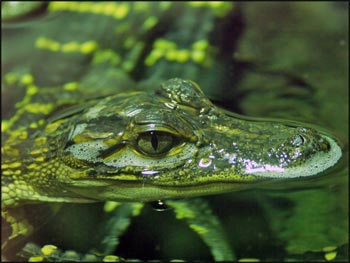Death Roll Behavior in Crocodilians
Biology 342 Fall 2006
Augustus Kilgore and Maya Jarrad
Ontogeny

Image courtesy of african-safari-pictures.com
The ontogeny of the behavior explains the learning process of a behavior iis learned in the context of the life cycle of the crocodilian.
Little is known about the ontogeny of rotational feeding. More research focus has been put into the ontogeny of bite force in A. mississippiensis than into the development of this feeding tactic. The research on the snout and teeth of both A. mississippiensis and C. crocodilus may lead to connections with physical development and the ontogeny of rotational feeding in the future.
When hatched, the alligator has a broad snout that elongates and narrows as it ages. Bite force changes during the ontogeny of the American alligator. A hatchling starts out very small, only 1/4000 of the adult size, reaching an average of 600 lbs later in lif.e Bite force is positively correlating with increases in body size. Scaling of biting forces through ontogeny showed positive allometry with respect to body mass, head length, jaw length, snout–vent length and total length (8). In addition, the bite force starts at 1/800 of its potential (measured in Newtons) (8). and torsional force starts at 0.015 N (1), which is 1/9000 of its potential of 138 N (1).
The juveniles in one study on rotational feeding mechanism averaged ~30 cm (1) , which indicates the organisms were very young, as hatchlings are about 23 cm long (6). The test group could exhibit rotational feeding at this young age. The young alligators stay close to their mother once hatched, but feed on their own (6). With their tiny, needle-like teeth, they quickly develop a way to tear large food apart without chewing. It is possible that the selective pressure among siblings for food drives the juveniles, even though they are protected form predation by their mother, to develop rotational feeding in order to consume larger prey, thereby increasing their fitness from this early age.
We look at the the spotted hyena (Crocuta crocuta), which also depends on extreme bite force to feed, having the second strongest of any living gnathostomes (jawed animal), partial only to A. mississippiensis. Hyena pups are also under strong selective pressure for rapid feeding, as food is often scarce and litters are large. The jaws of juveniles are not completely developed, but must be able to provide the pup with enough force to deconstruct whatever part of the carcass available to them. Unlike A. mississippiensis, there is little known about the development of bite force in C. crocuta, although it is expected to also increase with age. Selective pressure may be acting on the young to wean later in order to minimize the effects of a reduced bite force, when the hyena is stronger and can endure a reduction in feeding efficiency. As a conjecture, before and after the switch to adult teeth, the young adult must have excellent feeding efficiency, whether through bite force or other tactics, in order to compete with the adults (7). Similarities between these two organisms, such as high bite force and cone-like teeth built for crushing but not shredding or chewing, may be a good link between the development of feeding behaviors in the juveniles of these species.